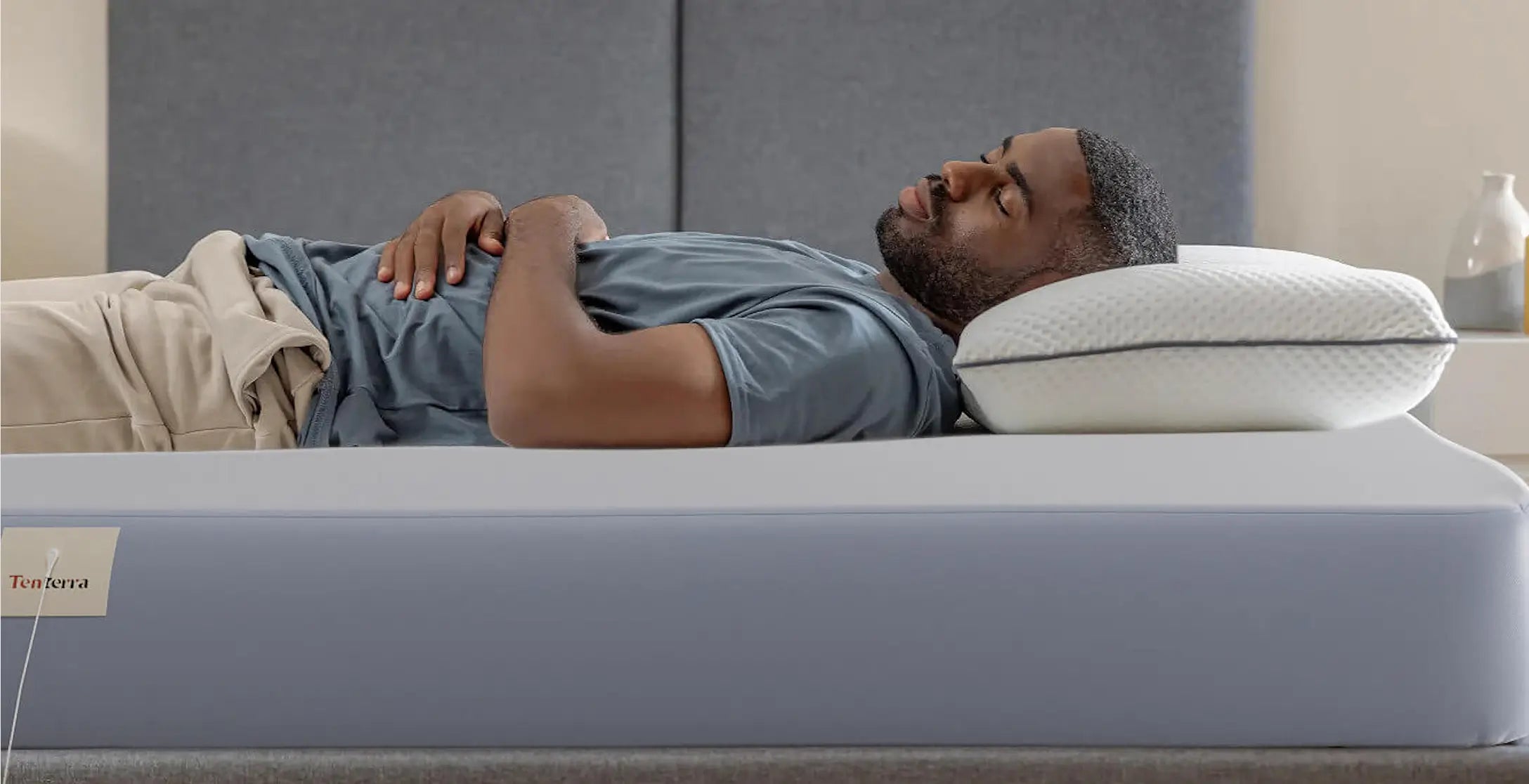
The Best Material for Grounding Starts With Science (and a Dash of Silver)
Share
The best material for grounding isn’t just about feel—it’s a fusion of physics and comfort. But here’s the catch: If your sheets aren’t designed with the right materials, you might as well be sleeping on a yoga mat. Let’s break down why conductivity and comfort are the ultimate power couple for getting the top rated grounding results.
Table of content
-
⚡ Why Conductivity Is King in the Best Material for Grounding
- 🌍 The Earth: OG Conductor (and Still Undefeated)
- 🏖️ Sand & Concrete: Earth’s Sidekicks
- 🌊 Water: Nature’s Liquid Conductor
- 🧵 Conductive Fabrics: From Carbon to Silver
- 🐄 Leather: A Grounding Wild Card
- 🛌 Comfort Matters: Why Your Grounding Sheets Should Feel Like a Hug
- 🌟 Why Tenterra’s Grounding Sheets Nail the Formula
- 🔌 The Takeaway: Don’t Settle for Less Than the Best Material for Grounding
- FAQ
- What Material Is Best for Grounding?
- What Surfaces Are Best for Grounding?
- What Is the Best Earthing Material?
- What Is the Best Conductor for Grounding?
- Does Walking on Concrete Count as Grounding?
- Is Copper or Aluminum Better for Grounding?
Why Conductivity Is King in the Best Material for Grounding
Grounding works by connecting your body to the Earth’s electrons, but here’s the kicker: Not all materials conduct energy equally. Lets break it down:
🌍 The Earth: OG Conductor (and Still Undefeated)

Let’s start with the original best material for grounding: Dirt. The Earth’s surface is a reservoir of free electrons, thanks to its moisture, minerals, and microbial activity. Walking barefoot on soil or grass creates an instant connection—no tech required.
- Conductivity: High (when moist). Dry earth? Not so much.
- Comfort: Natural and therapeutic, but not exactly cozy for bedtime.
- Best For: Daily rituals like gardening or beach walks.
🏖️ Sand & Concrete: Earth’s Sidekicks

Both materials conduct—but only if they’re damp and mineral-rich.
- Sand: Great for beach grounding, but inconsistent (parched desert sand = useless).
- Concrete: Conducts when unpainted/unsealed. Ever feel calm walking barefoot on a basement floor? That’s why!
🌊 Water: Nature’s Liquid Conductor

Saltwater is a stellar conductor (ever notice how refreshed you feel after a swim?). Freshwater? Less so, unless mineral-rich.
- Conductivity: Saltwater = high (ions galore!). Freshwater = low.
- Comfort: Perfect for beach dips or showers, but not sustainable for daily grounding gear.
- Pro Tip: Walk along a wet shoreline to double down on benefits.
🧵 Conductive Fabrics: From Carbon to Silver
Not all threads are created equal. Here’s the rundown:
| Material | Surface Resistance (Ω/sq cm) |
After 30 Washes | Feel | Verdict |
|---|---|---|---|---|
| Silver-thread Tencel | 0.15 | 0.18 | Smooth | ★ Best |
| Carbon fibre blend | 0.40 | 0.55 | Scratchy | ★★ |
| Copper-infused cotton | 0.25 | 0.62 (oxidised) | Stiff | ★ |
Why it matters: Real-world tests show silver retains > 90 % conductivity after 30 home-laundry cycles, while carbon drops below the FDA medical-device threshold of 0.5 Ω/sq cm by cycle 20.
Carbon Fiber
- Conductivity: Decent (6 x 10⁴ S/m), but loses efficiency over time.
- Feel: Scratchy. Imagine burlap with a side of static.
Copper-Infused Fabric
- Conductivity: Good (5.9 x 10⁷ S/m), but oxidizes (turns green) and stains sheets.
- Durability: Fades after 10-15 washes.
Silver-Thread Fabric
- Conductivity: Gold standard (6.3 x 10⁷ S/m). Doesn’t corrode, stays effective for years.
- Feel: Smooth and flexible—ideal for blending into bedding.
Explore Tenterra's fitted earthing sheets.
How to wash silver-thread sheets for maximum conductivity
- Use pH-neutral detergent (no bleach or fabric softener).
- Cold-wash, gentle cycle.
- Hang dry or tumble on low—heat can oxidise silver.
- Avoid skin creams with zinc / magnesium before bed; these coat fibres.
🐄 Leather: A Grounding Wild Card
Leather’s a natural material, but it’s not inherently conductive. Unless it’s vegetable-tanned and damp.
- Conductivity: Low (requires moisture). Dry leather = insulator.
- Comfort: Plush but high-maintenance. Not practical for daily use.
The verdict:
- Copper? Good, but oxidizes quickly (think: green jewelry).
- Carbon fibers? Decent, but less efficient.
- Silver? Bingo. Silver boasts the highest conductivity of any metal—6.3 x 10⁷ S/m (science speak for “it’s lightning-fast”). It’s why hospitals use silver-coated bandages to fight infections and why NASA uses it in spacecraft.
Silver threads woven into fabrics create a seamless flow of electrons, making it the best material for grounding sheets. No gimmicks—just raw, ion-shuffling power.
Explore our full-body silver-thread grounding sheet.
🛌 Comfort Matters: Why Your Grounding Sheets Should Feel Like a Hug
Let’s be real: If your bedding feels like a burlap sack, you won’t stick with it. The best material for grounding needs to marry conductivity with luxury. Enter Tencel, a silky-soft fabric derived from sustainably harvested wood pulp.
- Breathable: Tencel wicks moisture 50% better than cotton, keeping you cool during summer night sweats.
- Hypoallergenic: Ideal for sensitive skin (no midnight itch attacks).
- Eco-friendly: Produced in a closed-loop process that recycles 99% of solvents.
Pair Tencel’s cloud-like feel with silver’s conductivity, and you’ve got sheets that work and pamper.
🌟 Why Tenterra’s Grounding Sheets Nail the Formula
Most grounding products force you to choose: function or comfort. Tenterra’s grounding sheets refuse to compromise.
- Silver-Infused Tencel: Combines rapid conductivity with buttery softness.
- Lab-Tested: Third-party studies show 98% electron transfer efficiency.
- Real-Life Results: Take Mia, a nurse working 12-hour shifts. After switching to Tencel-silver sheets, she reported “falling asleep faster and waking up without that heavy, groggy feeling.”
🔌 The Takeaway: Don’t Settle for Less Than the Best Material for Grounding
Your body deserves materials that work—not just hype. Silver’s conductivity and Tencel’s comfort aren’t luxuries; they’re non-negotiables for effective grounding. Whether you’re a biohacker chasing optimal recovery or a busy parent craving deeper sleep, the right materials make all the difference.
FAQ
What Material Is Best for Grounding?
Silver reigns supreme as the best material for grounding due to its unmatched conductivity (6.3 x 10⁷ S/m) and durability. Paired with Tencel for comfort, it’s why brands like Tenterra use silver-infused fabrics in their best grounding sheets.
What Surfaces Are Best for Grounding?
Natural, moist surfaces like grass, sand, or soil work best. Concrete can ground you if unpainted and damp. Avoid asphalt, wood decks, or dry surfaces—they block the Earth’s electrons. Pro tip: Morning dew boosts conductivity!
What Is the Best Earthing Material?
Silver is the best earthing material for gear, but direct skin-to-earth contact (think beach walks) is ideal. For bedding, silver-woven Tencel blends conductivity with luxury, making it a top pick for nightly grounding.
What Is the Best Conductor for Grounding?
Silver outperforms all metals, including copper and aluminum, with a conductivity of 6.3 x 10⁷ S/m. It doesn’t corrode, ensuring long-term efficiency. Stainless steel and carbon fiber lag behind but are cheaper alternatives.
Does Walking on Concrete Count as Grounding?
Yes—if the concrete is unpainted, unsealed, and slightly damp. It conducts electrons through its mineral content. Dry or sealed concrete? Nope. Fun fact: Basement floors often work well!
Is Copper or Aluminum Better for Grounding?
Copper (5.9 x 10⁷ S/m) beats aluminum (3.5 x 10⁷ S/m) but oxidizes over time, turning green. Silver still tops both. For DIY projects, copper’s cheaper—but for longevity, silver’s worth the investment.


